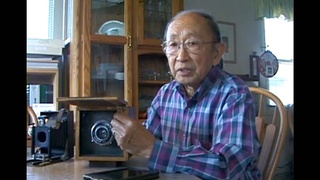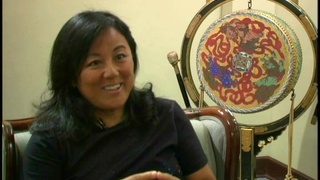Entrevistas
Losing his sister in camp
She got leukemia, a form of leukemia that uh she had to be hospitalized. And it took her a long time for her to die.
The hospital was outside of the camp proper, and uh where you had to go through a fence and guards to get... go to camp. So you couldn't visit. My mother was always there as I recall. And my father was there quite often. So we were left alone, most of the time. And it affected not me more than my younger sister because she never had a mother, you know. So, she blamed it on her sister for...being as a kid that is thinking terms of the jealousy factor, as competition.
But anyways she was um in hospital for a while. There's two things that they reckoned with prolonged her death was that uh she had a blood transfusion there. Just about everybody in that block gave blood, you know. And then the church was praying for her. That was the story I got. So the...my father told them, and mother said, I don't think...I think she's suffering too much so don't pray.
Well my mother never recovered. I'm sure she didn't. My father was um he was a real tough guy. In the sense that he knew what situation he was in. He never really showed this, saw this. He retained his dignity and his strength to not fall apart. And he kept saying now we must go on and all this kind of... You know, it was ganbatte. You know, he was really not um sort of you know in a state that he couldn't reorganize, keep the family together. He kept it together. I know it, I know I, he...he was quite upset...quite angry but it never showed He had to go along with the Japanese tradition. He had to be Nihonjin and not go into... you know fall apart.
So that was what... and then when my sister and broth..died... my..my sister died she was cremated. And then I understand a lot of them were buried too, right. But this is uh..my sister told me this the other day they were buried in a junkyard. You know? And uh in unmarked graves, you know, which they used to do in Germany, you know, with... with the victims, you know.
Fecha: June 29, 2012
Zona: California, US
Entrevista: Chris Komai, John Esaki
País: Watase Media Arts Center, Japanese American National Museum
Explore More Videos


Su padre no pasaba mucho tiempo con la familia (Inglés)
(1924–2016) Fotógrafo y empresario.

Unable to work when the war broke out
(1913-2013) Doctor, especialista en obstetricia en California del Sur



Mirando hacia adentro
(n. 1962) Poeta peruano, descendiente de Okinawa


Acerca de la educación del idioma japonés para niños
Profesor de doctorado en la Facultad de Derecho de la Universidad de São Paulo, abogado, traductor (nacido en 1948)

Speaking about his wife
(1928 - 2008) Recluta de la Armada Imperial de Japón y de la Armada Norteamericana

Growing up with both Japanese and American influences
(1919-2020) Miembro del Batallón de Ingenieria 1800. Promovió el comercio japonés americano mientras trabajaba en la división de exportación de Honda

Angry about the mistranslations of his father’s testimonies
(1919-2020) Miembro del Batallón de Ingenieria 1800. Promovió el comercio japonés americano mientras trabajaba en la división de exportación de Honda

Not able to go to Manzanar on a furlough
(1919-2020) Miembro del Batallón de Ingenieria 1800. Promovió el comercio japonés americano mientras trabajaba en la división de exportación de Honda

“All I have dear to me is in the camp”
(1919-2020) Miembro del Batallón de Ingenieria 1800. Promovió el comercio japonés americano mientras trabajaba en la división de exportación de Honda

My daughter’s identity (Japanese)
(n. 1979) Sansei brasileño reside en Oizumi-machi, Prefectura de Gunma. Administra una oficina de Diseño Gráfico.

Feelings upon listening to the imperial rescript (Japanese)
(1928 - 2008) Recluta de la Armada Imperial de Japón y de la Armada Norteamericana
